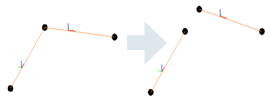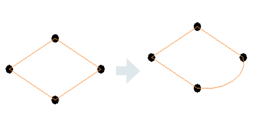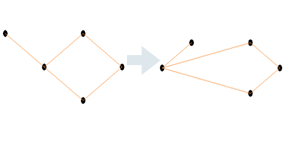Explorez l’API nouvellement développée dans le contexte de la modélisation analytique.
- Bénéficiez d’une liberté de modélisation analytique qui reflète leurs décisions de conception individuelles en ce qui concerne les éléments structurels et les bâtiments/structures vus comme des systèmes entiers.
- Représentez de manière analytique tous les types de structures.
- Créez des modèles analytiques cohérents en activant les tâches d’analyse structurelle à partir des modèles Revit.
- Effectuez un workflow bidirectionnel complet avec le logiciel d’analyse et capturez les modifications apportées au modèle.
- Si nécessaire, protégez le modèle analytique contre les modifications inattendues.
- Créez plusieurs modèles analytiques reflétant différents types d’analyse et configurations.
- Recréez la facilité de la modélisation analytique d’un logiciel d’analyse de structure dédié, associée à la puissance de la collaboration et des paramètres d’une plate-forme BIM.
Éléments Revit avec une nouvelle API
Nouvelles classes d’API
AnalyticalElement : représente la classe de base pour tous les objets analytiques. Elle remplace AnalyticalModel.
-
Transform GetTransform () - Returns the transform which reflects Analytical Element orientation.
-
AnalyzeAs AnalyzeAs - This represents the Analyze As parameter assigned to Analytical Element.
-
Reference GetReference (AnalyticalModelSelector selector) - Returns a reference to a given curve within the Analytical Element.
-
ElementId MaterialId - Defines the Material Id for the Analytical Element.
AnalyticalMember : représente un élément linéaire dans le modèle analytique structurel. Elle remplace AnalyticalModelStick et AnalyticalModelColumn.
-
AnalyticalMember Create(Document aDoc,Curve curve) - Method which creates a new instance of an Analytical Member within the project.
-
AnalyticalStructuralRole StructuralRole - The structural role assigned to the Analytical Member.
-
Curve GetCurve () - Returns the curve of the Analytical Member.
-
void SetCurve(Curve curve) - Sets the curve for the Analytical Member. This method disconnects elements from other analytical elements (if the end nodes are in the same position).

If the user wants to move the corner, and keep the connection, there are other ways for achieving that such as ElementTransformUtils.moveElements.
-
bool IsValidCurve(Curve curve) - Verifies if the curve is valid for an Analytical Member.
-
void FlipCurve() - Flips the ends of the Analytical Member.
-
StructuralSectionShape StructuralSectionShape - The structural section shape of the Analytical Member (read only).
-
ElementId SectionType - The id of the type from the structural family assigned to the Analytical Member.
-
double CrossSectionRotation - Cross-section rotation of the Analytical Member.
-
AnalyticalPanel Create(Document aDoc, CurveLoop curveLoop) - Method which creates a new instance of an Analytical Panel within the project.
-
CurveLoop GetOuterContour() - Returns the Curve Loop that defines the geometry of the Analytical Surface element.
-
bool IsCurveLoopValid(CurveLoop profile) - Checks if curve loop is valid for Analytical Panel.
- Pour modifier la géométrie du panneau analytique, les utilisateurs doivent utiliser la structure SketchEditScope. Cette fonctionnalité a été améliorée avec une nouvelle méthode :
-
void StartWithNewSketch(ElementId elementId) - Starts a sketch edit mode for an element which, at this moment, doesn't have a sketch.
-
- Autre méthode de modification de la géométrie :
-
void SetOuterContour(CurveLoop outerContour) - Sets the Curve Loop that defines the geometry of the Analytical Surface element.

-
Comme pour AnalyticalMember, la définition du contour du panneau analytique rompt la connexion avec d’autres éléments analytiques. Si l’utilisateur souhaite déplacer le coin et conserver la connexion, il existe d’autres méthodes pour y parvenir, telles que ElementTransformUtils.moveElements.
-
- Pour modifier la géométrie du panneau analytique, les utilisateurs doivent utiliser la structure SketchEditScope. Cette fonctionnalité a été améliorée avec une nouvelle méthode :
-
ISet<ElementId> GetAnalyticalOpeningsIds() - Returns the Analytical Openings Ids of the Analytical Panel.
-
ElementId SketchId - Sketch associated to this Revit element.
-
AnalyticalStructuralRole StructuralRole - Structural role assigned to the Analytical Panel.
-
AnalyticalOpening Create(Document doc, CurveLoop curveLoop, ElementId panelId) - Method which creates a new instance of an Analytical Opening within the project.
-
CurveLoop GetOuterContour () - Returns the Curve Loop that defines the geometry of the Analytical Surface element.
-
bool IsCurveLoopValidForAnalyticalOpening(CurveLoop loop, Document aDoc, ElementId panelId) - Checks if curve loop is valid for Analytical Opening.
- Pour modifier la géométrie d’ouverture analytique, utilisez la structure SketchEditScope.
- Vous pouvez également modifier la géométrie d’ouverture analytique de la manière suivante :
-
void SetOuterContour(CurveLoop outerContour) - Sets the Curve Loop that defines the geometry of the Analytical Surface element.
-
-
ElementId PanelId - ElementId of the host Analytical Panel.
-
ElementId SketchId - Sketch associated to this Revit element.
AnalyticalToPhysicalAssociationManager : gère les associations entre les éléments analytiques et physiques. Auparavant, les éléments eux-mêmes se reconnaissaient, et l’utilisateur n’avait aucun contrôle sur eux (l’association ne pouvait pas être modifiée). Avec cette nouvelle approche, l’association est modifiable. L’association 1 à 1 est prise en charge, et les éléments ne peuvent pas faire partie de plusieurs associations à la fois.
-
AnalyticalToPhysicalAssociationManager GetAnalyticalToPhysicalAssociationManager(Document doc) Returns the AnalyticalToPhysicalAssociationManager for this document.
-
void AddAssociation(ElementId analyticalElementId, ElementId physicalElementId) - Adds a new association between an analytical element and a physical element.
-
void RemoveAssociation(ElementId elementId) - This method will remove the association for the element with the given ElementId.
-
ElementId GetAssociatedElementId (ElementId elementId) - Returns id of the element which is associated with the given ElementId.
-
bool HasAssociation(ElementId id) - Verifies if the element has already defined an association.
-
AnalyticalNodeData GetAnalyticalNodeData ( Element element) - Returns AnalyticalNodeData associated with this element, if it exists.
-
AnalyticalNodeConnectionStatus GetConnectionStatus () - Returns the Connections Status for an Analytical Node.
AnalyticalLinks, BoundaryConditions et Loads ont été migrés pour fonctionner avec les nouveaux éléments. L’API associée reste la même dans la plupart des cas. Des améliorations ont été apportées aux charges.
-
LineLoad.Create(Document aDoc,ElementId hostElemId, XYZ forceVector1, XYZmomentVector1, LineLoadType symbol).
-
LineLoad.Create(Document aDoc,ElementId hostElemId, int curveIndex, XYZ forceVector1, XYZ momentVector1, Structure.LineLoadType symbol).
-
LineLoad.IsValidHostId(Document doc, ElementId hostElemId).
-
AreaLoad.IsValidHostId(Document doc, ElementId hostElemId).
-
AreaLoad.Create(Document doc, ElementId hostElemId, XYZ forceVector1, AreaLoadType symbol).
-
PointLoad.Create(Document doc, ElementId hostElemId, AnalyticalElementSelector selector, XYZ forceVector, XYZ momentVector, AreaLoadTyp symbol).
-
PointLoad.IsValidHostId(Document doc, ElementId hostElemId).
Échantillons
Création d’un membre analytique
using (Transaction transaction = new Transaction(document, "Create Analytical Member"))
{
transaction.Start();
//create curve which will be assigned to the analytical member
Line line = Line.CreateBound(new XYZ(0, 0, 0), new XYZ(5, 0, 0));
//create the AnalyticalMember
AnalyticalMember analyticalMember = AnalyticalMember.Create(document, line);
analyticalMember.StructuralRole = AnalyticalStructuralRole.StructuralRoleBeam;
transaction.Commit();
}
Création d’un panneau analytique
using (Transaction transaction = new Transaction(revitDoc, "Create Analytical Panel"))
{
transaction.Start();
//create the curveLoop for the AnalyticalPanel element
CurveLoop profileloop = new CurveLoop();
profileloop.Append(Line.CreateBound(new XYZ(1, 1, 0), new XYZ(2, 1, 0)));
profileloop.Append(Line.CreateBound(new XYZ(2, 1, 0), new XYZ(2, 2, 0)));
profileloop.Append(Line.CreateBound(new XYZ(2, 2, 0), new XYZ(1, 2, 0)));
profileloop.Append(Line.CreateBound(new XYZ(1, 2, 0), new XYZ(1, 1, 0)));
//create the AnalyticalPanel
analyticalPanel = AnalyticalPanel .Create(revitDoc, profileloop);
transaction.Commit();
}
Ajout d’une association entre un élément physique et un élément analytique
using (Transaction trans = new Transaction(doc, "AddAssociationBetweenPhysicalAndAnalyticalElements"))
{
trans.Start();
ElementId analyticalElementId = ContextualAnalyticalModel.Utilities.GetSelectedObject(activeDoc, "Please select analytical element");
ElementId physicalElementId = ContextualAnalyticalModel.Utilities.GetSelectedObject(activeDoc, "Please select physical element");
//gets the AnalyticalToPhysicalAssociationManager for the current document
AnalyticalToPhysicalAssociationManager analyticalToPhysicalManager = AnalyticalToPhysicalAssociationManager.GetAnalyticalToPhysicalAssociationManager(doc);
if (analyticalToPhysicalManager == null)
return Result.Failed;
//creates a new association between physical and analytical elements
analyticalToPhysicalManager.AddAssociation(analyticalElementId, physicalElementId);
trans.Commit();
}
Modification de la limite d’un panneau analytique à l’aide de la structure SketchEditScope

// Start a sketch edit scope
SketchEditScope sketchEditScope = new SketchEditScope(document, "Replace line with an arc");
sketchEditScope.StartWithNewSketch(analyticalPanel.Id);
using (Transaction transaction = new Transaction(document, "Modify sketch"))
{
transaction.Start();
//replace a boundary line with an arc
Line line = null;
Sketch sketch = document.GetElement(analyticalPanel.SketchId) as Sketch;
if (sketch != null)
{
//find first line in the sketch profile
…..
}
// Create arc
XYZ normal = line.Direction.CrossProduct(XYZ.BasisZ).Normalize().Negate();
XYZ middle = line.GetEndPoint(0).Add(line.Direction.Multiply(line.Length / 2));
Curve arc = Arc.Create(line.GetEndPoint(0), line.GetEndPoint(1), middle.Add(normal.Multiply(20)));
// Remove element referenced by the found line.
document.Delete(line.Reference.ElementId);
// Model curve creation automatically puts the curve into the sketch, if sketch edit scope is running.
document.Create.NewModelCurve(arc, sketch.SketchPlane);
transaction.Commit();
}
sketchEditScope.Commit(new FailurePreproccessor());
Déplacement d’un nœud analytique et conservation de la connexion

// Create Analytical Panel
AnalyticalPanel analyticalPanel = CreateAnalyticalPanel.CreateAMPanel(document);
// Create the connected Analytical Member
AnalyticalMember analyticalMember = CreateAnalyticalMember.CreateMember(document);
// Select the node
Reference eRef = activeDoc.Selection.PickObject(ObjectType.PointOnElement , "Select an Analytical Node");
// Move the Analytical Node using ElementTransformUtils
using (Transaction transaction = new Transaction(document, "Move node with ElementTransformUtils"))
{
transaction.Start();
ElementTransformUtils.MoveElement(document, eRef.ElementId, new XYZ(-5, -5, 0));
transaction.Commit();
}
Obtention des points de la courbe de la surface analytique
private List<XYZ> GetSurfaceContourPoints( Document doc, ElementId elementId )
{
// Create point list, get list of curves from analytical model
List<XYZ> contourPoints = new List<XYZ>();
AnalyticalModel analyticalModel = (doc.GetElement(elementId) as AnalyticalModel);
IList<Curve> curves = analyticalModel.GetCurves(AnalyticalCurveType.RawCurves);
// Iterate over curves and make the desired processing
…...
return contourPoints;
}
private List<XYZ> GetSurfaceContourPoints( Document doc, ElementId elementId )
{
// Create point list, get list of curves from analytical model
List<XYZ> contourPoints = new List<XYZ>();
AnalyticalPanel analyticalPanel = (doc.GetElement(elementId) as AnalyticalPanel);
CurveLoop outerContour = analyticalPanel.GetOuterContour();
// Iterate over curves and make the desired processing
…...
return contourPoints;
}
Extrait l’élément analytique associé d’un élément physique
AnalyticalElement GetAnalyticalElement(Element physicalElement)
{
AnalyticalElement analyticalElement = null;
Document document = element.Document;
AnalyticalToPhysicalAssociationManager assocManager = AnalyticalToPhysicalAssociationManager.GetAnalyticalToPhysicalAssociationManager(document);
if (assocManager != null)
{
ElementId associatedElementId = assocManager.GetAssociatedElementId(physicalElement.Id);
if (associatedElementId != ElementId.InvalidElementId)
{
Element associatedElement = document.GetElement(associatedElementId);
if (associatedElement != null && associatedElement is AnalyticalElement)
{
analyticalElement = associatedElement as AnalyticalElement;
}
}
}
return analyticalElement;
}
Création de conditions aux limites de lignes
Avec la solution précédente :
private BoundaryConditions CreateLineBC(Element hostElement)
{
Document createDoc = hostElement.Document.Create;
// use Document.NewLineBoundaryConditions Method
BoundaryConditions createdBC =
createDoc.NewLineBoundaryConditions(hostElement.GetAnalyticalModel(), 0, 0, 0, 0, 0, 0, 0, 0);
return createdBC;
}
Avec la nouvelle solution :
private BoundaryConditions CreateLineBC(Element hostElement)
{
Document createDoc = hostElement.Document.Create;
// use Document.NewLineBoundaryConditions Method
AnalyticalElement analyticalElement = GetAnalyticalElement(hostElement);
BoundaryConditions createdBC =
createDoc.NewLineBoundaryConditions(analyticalElement, 0, 0, 0, 0, 0, 0, 0, 0);
return createdBC;
}